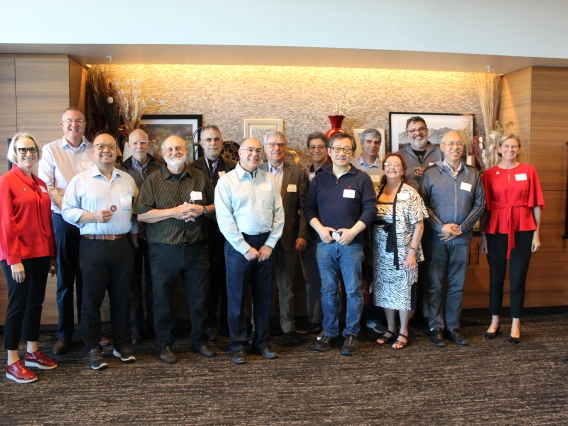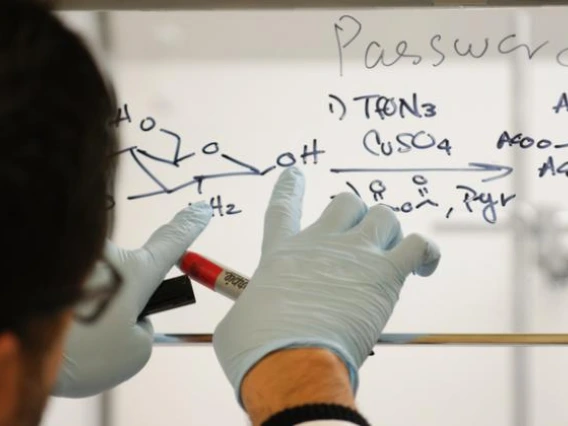College Celebrates Engineering Patents
The second annual Patent Medallion Luncheon recognized 17 engineering faculty for 24 inventions.

The 2023 Patent Medallion recipients pose for a photo. Photo courtesy of Tech Launch Arizona.
The College of Engineering and Tech Launch Arizona recognized 20 inventors for their ingenuity at the second annual Patent Medallion Luncheon in early March. The engineers received medallions to commemorate their patented inventions — which ranged from a quantum computing advance to a new construction material to biomedical devices.
The College of Engineering is a leader at the University of Arizona in invention disclosures and patents. Of all university patents in the most recent fiscal year, 20% were issued to College of Engineering faculty and their collaborators.
Judith Su, an assistant professor of optical sciences and biomedical engineering, continues to advance her work in developing optical sensors for medical diagnostics and prognostics, environmental monitoring and basic science research. She has developed a technique known as FLOWER, or Frequency Locked Optical Whispering Evanescent Resonator, that allows for the diagnosis of a variety of diseases at their earliest stages.
Hao Xin, working with fellow electrical and computer engineering instructors Siyang Cao and Min Liang, is using radar to make breakthroughs in driverless technology.
At the luncheon, Doug Hockstad, assistant vice president of Tech Launch Arizona, thanked the inventors for their part in bringing the university to its second year as No. 28 in the world among universities granted U.S. utility patents. The position marks an 11-point jump from its 2021 position and a 38-point jump from the year prior.
“The College of Engineering’s engagement with TLA and its commitment to creating impact from research and innovation is a model for the university,” Hockstad said. “That commitment, combined with the college’s current expansion, bodes incredibly well for the future, and we’re excited to grow our involvement and help shepherd many more impactful inventions from these top-performing investigators to create a better world.”
David W. Hahn, the Craig M. Berge Dean of the College of Engineering, expressed pride in the patents earned over the past year.
“The diversity of these inventions demonstrates the many ways our Arizona engineers are serving humanity and advancing knowledge. I’m honored to recognize this group of innovators for their commitment to excellence, in collaboration with our partners at Tech Launch Arizona,” Hahn said.
The following faculty members, graduate students and alumni received their medallions.
Aerospace and Mechanical Engineering
Linan Jiang – Micro-Scale Concentrated Photovoltaic Module and Polymer Waveguide Interconnect Between Chips
Peiwen Li – High Temperature Fuel Cell System
Jekan Thanga – Laser Position Control and Space Traffic Management
Biomedical Engineering
Carissa Grijalva (graduate student) – Active Assist Orthotic
Minkyu Kim – Antimicrobial Biopolymers for Microbial Infections
Marek Romanowski – Ocular Cranial Nerve Monitoring System
Marvin Slepian – Determining Overall Motion and Flexibility Envelope; Systems and Methods for Characterizing Sepsis; and System for Monitoring Therapeutic Procedures
Tsu-Te Judith Su – Photonic Apparatus, Methods, and Applications
Chemical and Environmental Engineering
Gregory Ogden and Kimberly Ogden – Optical Device for Monitoring of Microorganisms
Electrical and Computer Engineering
Siyang Cao, Min Liang (alum) and Hao Xin – Automotive Radar Using 3D Printed Luneburg Lens
Wolfgang Fink – Vehicular Tip or Rollover Protection Mechanisms and Traverse Optimization and Multi-Purpose Tracking
Min Liang (alum) and Hao Xin – Hollow Light Weight Lens Structure
Mining and Geological Engineering
Jinhong Zhang – Material with Improved Strength/Water Resistance
Materials Science and Engineering
Pierre Deymier – Systems and Methods for the Tunability of Phase in Quantum-Like Mechanical Elastic Systems
Douglas Loy – Dihydropyridazine Antioxidant Sunscreens and Forming a Network Foam Using Diels-Alder Reactions
Optical Sciences and Engineering
Chaohan Cui (graduate student) – Quantum Receiver Method Decoding an Optical Signal



